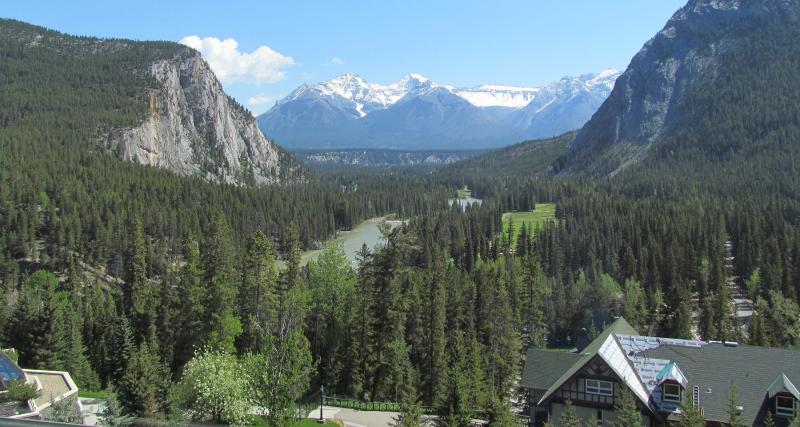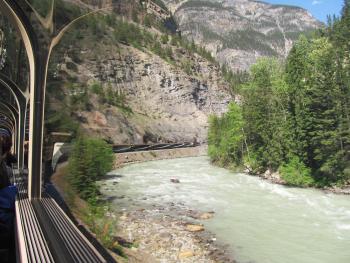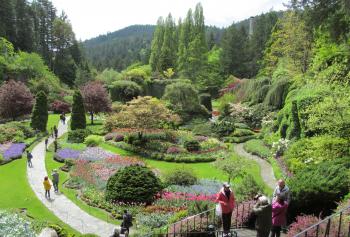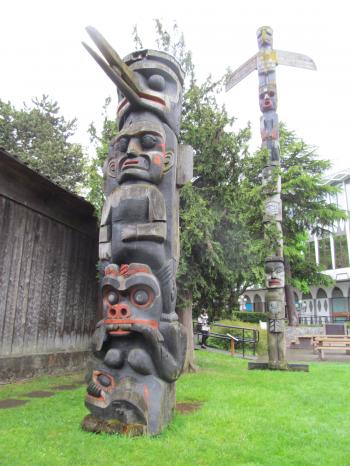Eastward Ho: Aboard Canada’s ‘Rocky Mountaineer’ from Vancouver to Banff
This article appears on page 47 of the October 2017 issue.
Some trips take a long time to get off the ground. The trip my husband, Paul, and I took to western Canada in May 2017 was one of those.
It all started with a great but too-short trip to Vancouver, British Columbia, in western Canada more than 20 years ago. Paul and I promised ourselves that when we next returned, it would be to not only see more of Vancouver but to travel through the Canadian Rocky Mountains, preferably by train.
Years flew by, and lots of trips were taken in those years, including some on trains, but none through the Canadian Rockies. Fast-forward to 2017.
This year, Canada is celebrating the 150th anniversary of its formation. What better time for us to celebrate, too, with a return to Vancouver, giving ourselves a long-delayed gift of a trip aboard the Rocky Mountaineer?!
The journey ahead
The Rocky Mountaineer (Vancouver, BC; 877/460-3200, www.rockymountaineer.com) offered dozens of choices, from all-inclusive 3- to 11-night packages to 2- or 3-day rail-only journeys transporting riders from point A to point B in luxurious comfort. The latter is what we chose: a 2-day journey from point A (Vancouver) to point B (Banff).
Wanting to make the trip as special as possible, we selected Rocky Mountaineer’s GoldLeaf service level, which featured a bilevel, glass-domed car and gourmet dining, both breakfasts and lunches, served in the lower-level dining car — well worth the extra expense.
On our arrival at the Rocky Mountaineer’s own train station in Vancouver, we were greeted with juice and coffee and a pianist tickling the ivories… at 7 a.m. Not long after we checked in, a bagpiper in full kilt regalia piped us aboard the train, and dozens of Rocky Mountaineer employees lined up beside the tracks to wave us off — an elegant touch.
Once we’d settled comfortably into our reclining seats beneath the glass dome, breakfast was announced, a leisurely paced affair with seven choices (smoked salmon and scrambled eggs for me, blueberry pancakes for Paul). It was a great way to kick-start our day and this long-awaited trip.
Impressive scenery
Soon we left Vancouver behind, and before we knew it, it was time for lunch, which was as special as breakfast, served on white tablecloths and with five selections, paired with several choices of wine from British Columbia.
The excellence of the cuisine was not what we had primarily signed up for, but it was a decidedly wonderful addition. However, it was a bit of a surprise, as in, ‘How do they manage to prepare this great food in the train’s small kitchen?’
The main draw, for us, was the opportunity to travel through some of the world’s most spectacular mountain scenery. This we got in abundance. First came the gentle beauty of the Fraser Valley, with its many vineyards, then the whitewater rapids and steep canyons of Hell’s Gate and the even more intimidatingly named Jaws of Death Gorge, where the banks of the river closed in to create a narrow passage. Finally, we reached Kamloops, our first night’s destination.
As we pulled into the Kamloops train station, we were greeted by two Canadian Mounties on horseback waving as the train slowed down. We had traveled 285 miles from Vancouver on day one of our journey.
The second day was, scenically, the more spectacular. Twenty-eight miles past Craigellachie, where the last spike of the Canadian Pacific Railway was driven in November 1885, linking Canada from coast to coast, we reached Revelstoke. From there to Banff, the scenery was so riveting that even the prospect of a gourmet lunch could not tempt me to leave my dome-car seat. (One of the solicitous attendants noticed and brought a mini-lunch to my seat, a small example of the kind of service we enjoyed aboard the train.)
What followed until we reached Banff in the early evening was an unfurling scroll of mountain passes, tunnels and bridges, pine forests, steep craggy ridges and snow-covered mountain peaks. Along the way, we crossed the Continental Divide, the highest point of our journey, at 5,332 feet. We also traveled through the Spiral Tunnels, the railway tracks burrowing through two mountains and doubling back upon themselves, and “lost” one hour by crossing from the Pacific Time Zone eastward into the Mountain Time Zone.
Did we see any wildlife along the way? Fleetingly, we spotted elk, bighorn sheep, moose and several black bear cubs. We did see lots of bald eagles. One train passenger claimed he saw Sasquatch, but that sighting may have come after his second whiskey and soda.
Though we’d traveled 310 miles on this day, it seemed we were suddenly in Banff, at the end of day two, the culmination of our train adventure.
The details
In 2018, the cost of the 2-day rail journey from Vancouver to Banff (or the reverse) will be $1,479 in SilverLeaf service from May through September and $1,232 from April 16 to 30 or October 1 to 12. GoldLeaf prices for the same periods are $2,013 and $1,685, respectively. I’d recommend opting for GoldLeaf, if you can, to make a great trip even more wonderful.
Departures are frequent. In May 2017 alone, when we traveled, there were 14 departures from Vancouver to Banff.
One “amenity” I loved was that our luggage was delivered directly to our hotel room mid-journey and at the end of the trip, so time was not wasted locating suitcases at the rail stations.
Banff stay
We chose Banff as the terminal point of our train journey primarily because of the Fairmont Banff Springs hotel (866/540-4406, www.fairmont.com/banff-springs).
The Banff Springs is one of the jewels in the crown of the Fairmont chain of hotels. It is as iconic as Québec’s Fairmont Le Château Frontenac hotel (where we dined three times during our stay in Québec City last year) and is the luxury equivalent, we felt, of our Rocky Mountaineer train.
We had only four nights there but made the most of our stay. As with GoldLeaf service aboard the train, we chose Gold-level accommodation at the Banff Springs because of the associated amenities, including a private concierge to reserve restaurants and tours plus a lounge reserved for Fairmont Gold guests, where complimentary Continental breakfast is served in the morning, hors d’oeuvres in late afternoon and soft drinks all day. Our spacious room faced a picture-postcard view of the river, forests and mountains.
Each night we dined in one of the hotel’s restaurants: Castello Ristorante (Italian), Waldhaus Restaurant (German), Samurai Sushi Bar & Restaurant (Japanese) and 1888 Chop House (steakhouse). Waldhaus was our favorite, for its fondues, with 1888 Chop House a close second for its steaks and sautéed fiddlehead ferns, a delicacy for us. Entrées at each restaurant averaged CAD35-CAD60 ($28-$48).
We did manage to break away from the hotel to do a few excursions: a short drive by taxi into tourist-clogged Banff for some souvenir shopping — don’t miss Rocks & Gems (137 Banff Ave.) and its sister store, Rock Paper Silver (221 Banff Ave.), for their collections of jewelry, many made with semiprecious stones mined in Canada — and a ride on the Banff Gondola for bird’s-eye views of the hotel and the surrounding national park, a UNESCO World Heritage Site.
We also did a day-long excursion to the Columbia Icefield ($307 for two) on the boundary between Banff and Jasper national parks. A giant-wheeled ice bus transported us to the Athabasca Glacier, one of several glaciers comprising the ice field, where we had the opportunity of slipping and sliding on the glacial ice. Do not miss this trip if you can squeeze it in.
Depending on the season, room prices vary, with standard rooms starting at $269 per night and Fairmont Gold rooms from $524.
A month in Vancouver
With our Rocky Mountaineer train journey beginning in Vancouver, a perfect starting point for this near-perfect trip, we decided to spend a month in Vancouver in a beautiful rental apartment right in the center of the downtown area before our departure. But if you don’t have a month to spare, allow at least three or four days in Vancouver before (or after) your train trip. You’ll kick yourself if you don’t!
There is so much to see and do, as well as so many fabulous places to dine, that all I can do is give a brief “menu” of what I feel should not be missed.
The sites at the very top of my list are the 1,000-acre Stanley Park, exhibiting a collection of Northwest Coast First Peoples totem poles, and the Museum of Anthropology, featuring indoor and outdoor totem poles along with other aboriginal artifacts, including bentwood boxes, carved doors and Haida artist Bill Reid’s world-famous “The Raven and the First Men” sculpture.
Only a fraction lower on my list are Canada Place, resembling a ship docked in the harbor with sails billowing in the breeze; the serene Nitobe Memorial Garden, with a Japanese teahouse and a koi pond; the Bill Reid Gallery of Northwest Coast Art, displaying the artist’s carvings, paintings and jewelry, and the tranquil Dr. Sun Yat-Sen Classical Chinese Garden in Chinatown, re-creating a Ming Dynasty scholar’s garden.
Still there is more! The vibrant Granville Island Public Market, offering edible temptations from handmade chocolates and plump fresh strawberries to fresh-out-of-the-oven bagels and heavenly smelling exotic spices; the Vancouver Art Gallery, with exhibits that include works by the renowned Canadian artist Emily Carr (1871-1945), who painted primeval-looking forests and Northwest Coast aboriginal villages, and Capilano Suspension Bridge Park, with its famous swaying bridge high above the river and its colorful First Nations totem poles — all places that should not be missed.
Rounding out the list are the beautifully manicured VanDusen Botanical Garden; Gastown, filled with cafés, restaurants and upscale art galleries selling Northwest Coast art, and the Vancouver Aquarium, whose inhabitants include stately African penguins, mesmerizingly beautiful jellyfish and playful sea otters.
Dining well
Since I’m suggesting must-see sights, let me also suggest some must-dine-in restaurants. We dined out almost every night and never had a mediocre meal, so I could, theoretically, suggest more than two dozen restaurants, but I’ll stick to our favorite half dozen, where entrées averaged CAD25 to CAD40 ($20-$32): Cardero’s Restaurant, Bacchus, Le Crocodile, Boulevard Kitchen & Oyster Bar, Fairmont Vancouver for elegant afternoon tea (CAD59 per person) and Salmon n‘ Bannock Bistro for the First Nations cuisine in which they specialize. (At the Salmon n‘ Bannock, try braised bison back ribs [CAD35] or birch-glazed wild sockeye salmon [CAD27], and don’t forget to add the unleavened bread called bannock.)
Victoria
We also managed to fit in three nights in Victoria, British Columbia’s capital. It’s just a 30-minute flight from Vancouver to Victoria’s inner harbor aboard a Harbour Air seaplane ($492 for the two of us), which takes off and lands on water.
The primary reason we wanted to visit Victoria (actually, revisit, since we’d been there once before) was to have afternoon tea at the Fairmont Empress Hotel (866/540-4429, www.fairmont.com/empress), located right on the inner harbor, a 10-minute walk from where the seaplane lands.
You don’t go to the Empress for just a quick cup of tea. This is teatime “extraordinaire,” served in the proper English fashion every day from 11 a.m. to 6 p.m., with raisin scones, assorted bite-sized morsels, like smoked salmon on blini and cucumber on rye, and pastries, together with a choice of 21 teas (or coffee, if you must). It was a leisurely, relaxing, tasty experience.
Be sure to make reservations way in advance; a month ahead is not too much. (We made ours four months ahead!) Tea for two will cost CAD150, not including tip — pricey, but you will probably not want dinner later on if you have tea mid-afternoon, as we did.
As good as having tea at the Empress is spending a night or two (or three) there. Our elegant room overlooked the harbor and a small section of Parliament, brilliantly outlined with lights at night. Standard rooms start at $354 per night, Fairmont Gold rooms at $467.
City sights
The “must sees” in and near Victoria include, at the very least, the Royal British Columbia Museum, with the fabulous First Peoples Galleries that feature dramatically lit totem poles in Totem Hall and an impressive Kwakwaka’wakw ceremonial house that you can walk inside; the adjacent Thunderbird Park, with more First Nations totem poles, and Butchart Gardens, located 13 miles northwest of Victoria in Brentwood Bay.
Butchart Gardens is one of the world’s great gardens. At the time of our visit in mid-May 2017, it was bursting with blooms. It was the perfect time to visit, although there is probably no bad time to visit this magnificent garden.
If you have more time in this city, I’d also recommend visits to the Art Gallery of Greater Victoria, with a Shinto shrine in its tiny garden and changing exhibits, and imposing Craigdarroch Castle, built in the late 19th century by wealthy coal baron Robert Dunsmuir, who filled it with Victorian-era furnishings and beautiful stained-glass windows.
Whistle stop in Whistler
Paul and I also did a day tour to Whistler, about a 2-hour drive each way from/to Vancouver along the scenic Sea-to-Sky Highway. Aside from the ride there and back, we were disappointed.
The Audain Art Museum, supposedly with one of the country’s largest collections of Emily Carr’s work plus a collection of Northwest Coast art, was closed. (Be sure to check their hours by phone before going.) Most of the restaurants were closed as well, except for several fast-food places.
Whistler was virtually a ghost town on our mid-week mid-May visit, perhaps precisely because it was mid-week and mid-May, which is in between the very busy winter skiing season and the equally busy summer hiking season. However, the majestic mountain and lake scenery en route made the trip worthwhile. F




